Thirty-six Views of Mount Fuji
From Bwtm
This page is about Thirty-six Views of Mount Fuji by the Japanese artist Katsushika Hokusai (1760–1849)
http://en.wikipedia.org/wiki/Thirty-six_Views_of_Mount_Fuji#Original_thirty-six
'Seven-League' Beach
36 Views of Mount Fuji Shichiri-ga-hama Suruga Province Koshigoe village on Enoshima Island in Sagami Bay by Hokusai
Katsushika Hokusai, Shichiri-ga-hama [Beach] in Suruga Province (Sōshū Shichiri-ga-hama), a colour woodblock print

This print belongs to what is thought to be the first group of five designs in the series, done originally entirely in shades of Berlin blue. Shichiri-ga-hama, 'Seven-League' Beach, lies in the foreground with Mt Fuji seen past the island of Enoshima in the middle-ground. Cumulonimbus clouds rise on the horizon, suggesting summer storms, and yet Fuji is well covered with snow.
Colour woodblock oban print. One of two views from series, part of first group of five designs printed in Berlin blue. Shichiri-ga-hama in foreground, Enoshima with massive trees and houses in Koshigoe village in middle-ground, Mt Fuji covered by snow in distance; cumulonimbus clouds rise on horizon. Trimmed on all sides except right. Inscribed, signed and sealed.
http://ukiyo-e.org/image/mfa/sc225391
Sazai Hall at the Temple of the Five Hundred Arhats (Gohyaku Rakanji Sazaidō)
36 Views of Mount Fuji Gohyaku Rakanji Sazaidō 62 miles from Mt. Fiji in Honjo by Hokusai
main
62 miles from Mt. Fiji

Colour woodblock print. Temple of the Five Hundred Arhats (rakan), in Honjo. Nishiki-e on paper. Inscribed, signed and sealed.
http://www.metmuseum.org/collections/search-the-collections/37321
ref
Sumida River http://en.wikipedia.org/wiki/Sumida_River
http://www.us-japan.org/edomatsu/honjo/frame.html
The Circular Pine Trees of Aoyama
36 Views of Mount Fuji Cushion Pine at Aoyama 59 miles from Mt. Fiji Garden of Rikugien by #Hokusai
Cushion Pine at Aoyama (Aoyama enza no matsu), from the series Thirty-six Views of Mount Fuji (Fugaku sanjūrokkei) Katsushika Hokusai (Japanese, Tokyo (Edo) 1760–1849 Tokyo (Edo))
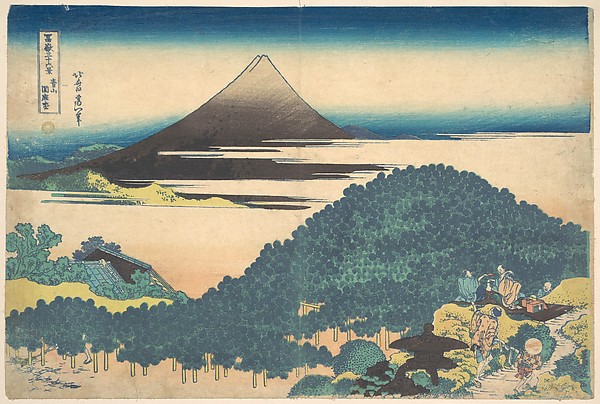
the famous pine tree in the garden of Ryuganji http://goo.gl/maps/rzKD1
http://www.metmuseum.org/collections/search-the-collections/36509
http://www.metro.tokyo.jp/ENGLISH/PROFILE/IMG/2012_en_6-7.pdf
Climbing on Fuji Shojin tozan
36 Views of Mount Fuji Climbing on Fuji Shojin tozan by #Hokusai Mt. Fiji is 3,776.24 m (12,389 ft) high
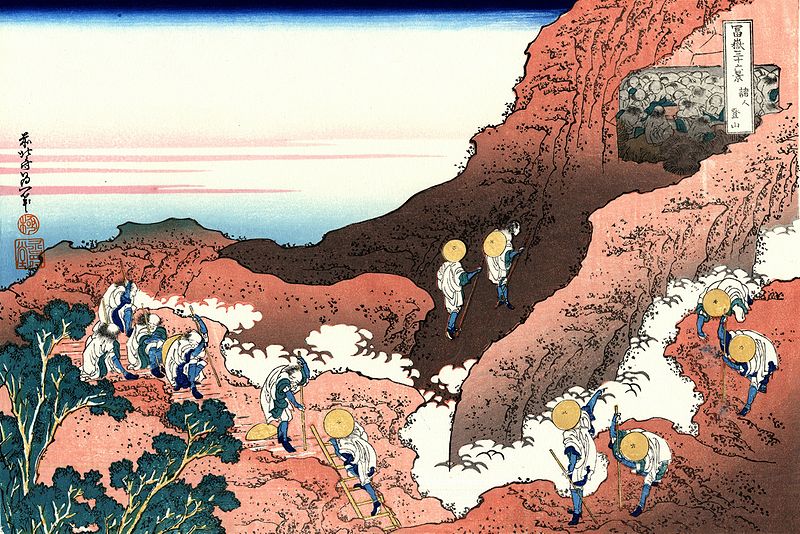
Unlike the other prints from the series, which portray Mount Fuji from a distance, this image depicts the very top of the sacred mountain, with pilgrims arriving at Fuji's breathtaking summit after an exhausting climb and making their way toward the mountain's grottoes for worship. http://www.metmuseum.org/collections/search-the-collections/56235
Colour woodblock oban print. Final design of series. Pilgrims in white jackets making way to cave on Mt Fuji at sunrise: some bracing themselves with wooden staffs as clambering over rocks; others pausing to rest and huddling together in cave. http://www.britishmuseum.org/research/collection_online/collection_object_details.aspx?objectId=783953&partId=1
Pilgrimage and Buddhist Art is the first major exhibition of its kind devoted to the impact of Buddhist pilgrimage on Asia’s artistic production. It highlights approximately 120 objects of importance and extraordinary quality, including sculptures, paintings, prints, ritual implements, photographs, and maps. http://asiasociety.org/arts/asia-society-museum/past-exhibitions/pilgrimage-and-buddhist-art
Enoshima in Sagami Province (Sōshū Enoshima)
36 Views of Mount Fuji #Hokusai Enoshima in Sagami Province dedicated to the goddess Benzaiten 45 miles from Mt Fuji
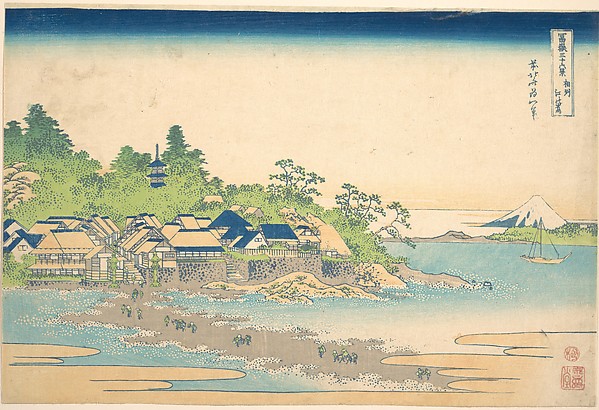
http://www.metmuseum.org/Collections/search-the-collections/56376
Enoshima: the picturesque island http://jamesang12.hubpages.com/hub/Enoshima-the-picturesque-island
Enoshima Jinja Shrine http://www.asahi-net.or.jp/~qm9t-kndu/enoshima.htm
Fujimigahara in Owari Province (Bishū Fujimigahara)
36 Views of Mount Fuji #Hokusai Fujimigahara in Owari Province cooper applying varnish to barrel 120 miles from Mt Fuji
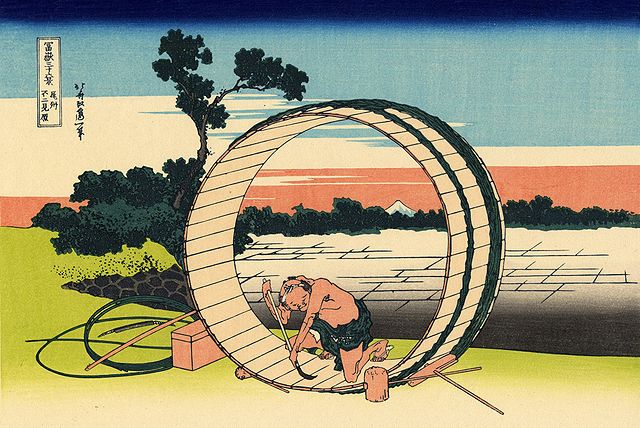
Print shows a cooper applying varnish to the inside of a large, bottomless barrel, with distant view, through the barrel and across a field, of Mount Fuji.
http://www.metmuseum.org/collections/search-the-collections/36500
Mount Fuji reflects in Lake Kawaguchi, seen from the Misaka Pass in Kai Province
36 Views of Mount Fuji #Hokusai Mount Fuji reflects in Lake Kawaguchi Kai Province 8 miles from the summit of Mt Fuji
甲州三坂水面 Kōshū Misaka suimen
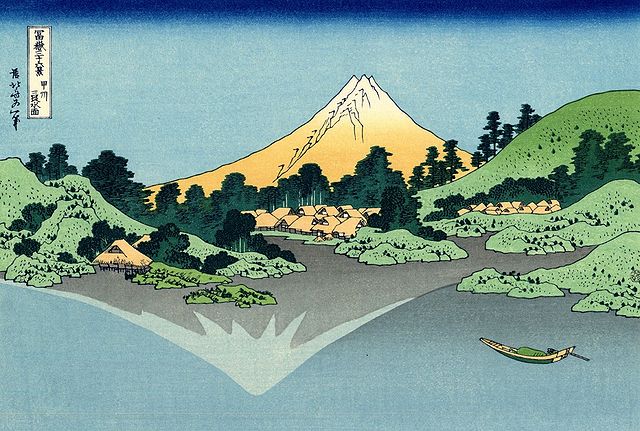
Colour woodblock oban print. View from Misaka Pass looking down on Lake Kawaguchi in summer or early autumn: Tan-coloured Mt Fuji with white summit, deep cleft in slopes and craggy triple-peak; reflection of Mt Fuji in lake with more covering snow. http://www.britishmuseum.org/research/collection_online/collection_object_details.aspx?objectId=783961&partId=1
The Great Wave off Kanagawa (神奈川沖浪裏 Kanagawa-Oki Nami-Ura
36 Views of Mount Fuji #Hokusai most famous The Great Wave off Kanagawa est 50 miles East of the summit of Mount Fuji
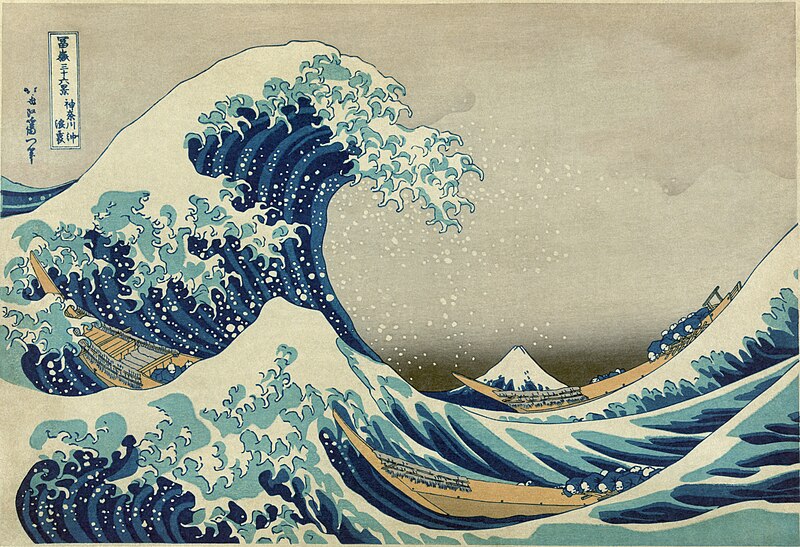
The breathtaking composition of this print ensures its reputation as a masterpiece; the great wave in the foreground is knowingly juxtaposed with the tiny Fuji in the hollow of the wave's angry crest. The clawlike wave heads that threaten to crash down upon the three boats conjure up images of mythical dragons. Like the helpless boats, Mount Fuji too appears on the verge of obliteration. http://www.metmuseum.org/collections/search-the-collections/45434
Hakone Lake in Sagami Province 『相州箱根湖水』 - Soshu Hakone kosui
36 Views of Mount Fuji #Hokusai Hakone Lake in Sagami Province (now Lake Ashinoko) 18 miles SE of the summit of Mount Fuji

http://www.loc.gov/pictures/item/2008661029/
Unlike the soft coloration of the aizuri print, this image dazzles with its bright, clear tones and brilliant light effects. Hokusai makes use of the cloud form common to traditional Japanese prints, the suyari gasumi, as a framing device to draw attention to the mountain. http://www.metmuseum.org/collections/search-the-collections/36498
Lake Ashi (芦ノ湖 Ashi-no-ko?), or Hakone Lake, Ashinoko Lake, is a scenic lake in the Hakone area of Kanagawa Prefecture in Honshū, Japan. It is a crater lake that lies along the southwest wall of the caldera of Mount Hakone, a complex volcano. The lake is known for its views of Mt. Fuji and its numerous hot springs. A number of pleasure boats and ferries traverse the lake, providing scenic views for tourists and passengers. Several of the boats are inspired by the design of sailing warships. http://en.wikipedia.org/wiki/Lake_Ashi
Onshi hakone Park http://www.kanagawa-park.or.jp/onsisite/about.html
Hodogaya on the Tōkaidō『東海道保土ケ谷』 - Tokaido Hodogaya
36 Views of Mount Fuji #Hokusai Hodogaya on the Tōkaidō present day Yokohama 49 miles east of the summit of Mount Fuji

Woodblock made ca. 1930 exactly the same way as they were made by artisans ca. 1830. The skill and the care are the same. There is a drawing or a copy of it coming from the artist. Then the woodcutter and the printer take over. Their skill varies. Hokusai once wrote to one of his editors that he was not happy with one of the woodcutters. In the case of the new cuts of the 36 views of the Fuji, only experts can distinguish the many versions - mainly by differences of the frame around the script. http://en.wikipedia.org/wiki/File:Hodogaya_on_the_Tokaido.jpg

Travellers on road lined with pine trees at Hodogaya: foot-traveller on far right with itinerant monk, deep sedge hat and bamboo flute, gazing at roadside stone image of deity carved into rock-face of hillside; palanquin bearers resting to mop brow and re-tie sandal; man leading horse pointing herding stick towards Mt Fuji in background.
Clark 2001Hodogaya was the fourth post-station on the Tokaido Highway, heading west out of Edo. After Hodogaya, the traveller would climb the incline of Gonta-zaka towards the border between the provinces of Musashi and Sagami at the top. Kobayashi suggests that the location here is the decline slope of Shinano-zaka on the other side, where aged pine trees lined the road (UT 1975, no. 36). Certainly the foot-traveller on the far right, heading east towards Edo, looks to be commencing a climb. He wears the distinctive apparel of an itinerant monk ('komuso'), face all but obscured by a deep sedge hat and a bamboo flute ('shakuhachi') pushed through his sash. Half cropped by the right side of the sheet can just be made out a roadside stone image of a deity - perhaps Fudo with his sword held vertical - apparently carved into the rock-face of the hillside. The monk's face is tilted upwards, presumably to gaze at this. The other travellers and the horse show evidence of their recent exertions over the hill, the palanquin bearers resting to mop a brow and re-tie a sandal. The only one admiring the view of Fuji is the man leading the horse, pointing his herding stick towards the mountain like a teacher at a blackboard. As seen several times before in the series, the trademark and seal of the publisher, Nishimuraya, are insinuated into the design, here as the motifs on the horse-blankets (The pattern on the blanket that passes under the horse's belly looks to be the stylized character 'ju' from Eijudo and on the cloth above the tail is the triple-tomoe trademark).Two shades of green enliven the rhythmical clusters of pine needles; dots of moss jump out of the bark and branches; above all, the swaying poses of the pine trees seem almost to turn them into a line of animate beings, graciously parting in the middle to show us Fuji. Now the shapes of the clusters of pine needles start to look like Fuji-shaped clouds filling the sky. The horse with its drooping head and tail, and the rider, with his white hat like snow on his summit, don't they combine to form another, animate Fuji in the foreground? Hokusai constantly set up these formal resonances within a composition.One early variant seems to be to have lime green on the foreground road, the grass on the hillside on the right and the foothills of Fuji (MOA 1982, no. 36). Also in the British Museum collection is an impression from the later, black-line printing of the design, with gradated orange on the horizon and black slopes of Fuji (1906.12-20.0534). All the grassy areas in the foreground are printed in pale green, rather than the Berlin blue seen here. http://www.britishmuseum.org/research/collection_online/collection_object_details.aspx?objectId=783972&partId=1
Hodogaya, one of the well-known fifty-three stations of the Tōkaidō road, is located between Musashi, the province in which Edo was located, and Sagami Province to the west. At this point, westbound travelers were said to have finally felt the sensation of having put the metropolis of Edo behind them, for at Hodogaya the road stretches into a beautiful avenue lined with pine trees on both sides. When one travels on foot along a course near a big mountain, one has the feeling that progress is slowed by the overwhelming immobility of the mountain that seems to be eternally watching. This sensation is lyrically expressed in this print. Fuji's immobility is emphasized in contrast to the gentle rhythm of the row of pine trees and the crawling pace of the travelers. http://www.metmuseum.org/Collections/search-the-collections/55458
The Tōkaidō (東海道 East Sea Road?) was the most important of the Five Routes of the Edo period, connecting Edo (modern-day Tokyo) to Kyoto in Japan. Unlike the inland and less heavily travelled Nakasendō, the Tōkaidō travelled along the sea coast of eastern Honshū, hence the route's name. http://en.wikipedia.org/wiki/Tōkaidō_(road)
google map http://goo.gl/maps/hJLm0
Asakusa Hongan-ji temple in the Eastern capital [Edo] 東都浅草本願寺 Tōto Asakusa honganji
36 Views of Mount Fuji #Hokusai Asakusa Hongan-ji temple Edo with kite 65miles east of the summit of Mount Fuji
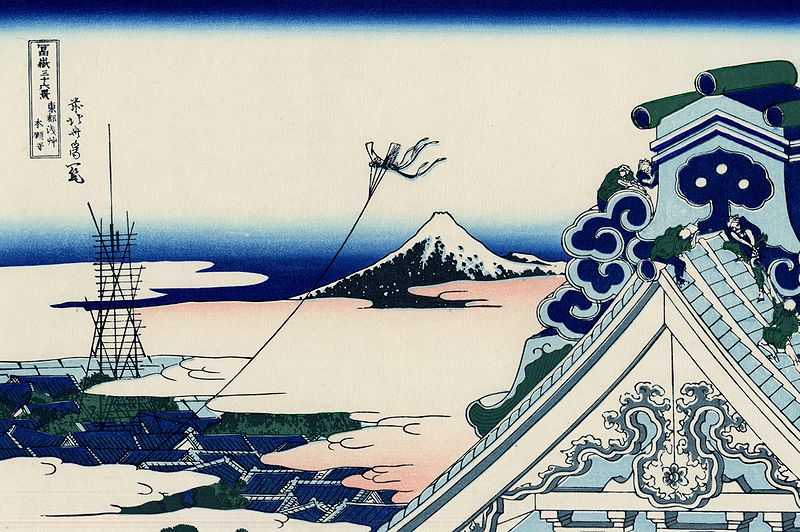
Print shows the peak of the roof of the Hongan-ji Temple at Asakusa with a kite flying through the clouds and a view of Mount Fuji in the distance. http://www.loc.gov/pictures/item/2008660875/
Google map: http://goo.gl/maps/JV77J
The Inume Pass in Kai Province 甲州犬目峠 Kōshū inume-tōge
36 Views of Mount Fuji #Hokusai Inume Pass in Kai Province 26.5miles Northeast of the summit of Mount Fuji

Print shows travelers and porters with two horses climbing the Inume Pass, with view of Mount Fuji in the distance. http://www.loc.gov/pictures/item/2008661013/
google maps http://goo.gl/maps/wJ4Pc
Dawn at Isawa in Kai Province 甲州伊沢暁 Kōshū Isawa no Akatsuki
36 Views of Mount Fuji #Hokusai Dawn at Isawa in Kai Province travelers depart 20miles North of the summit of Mount Fuji
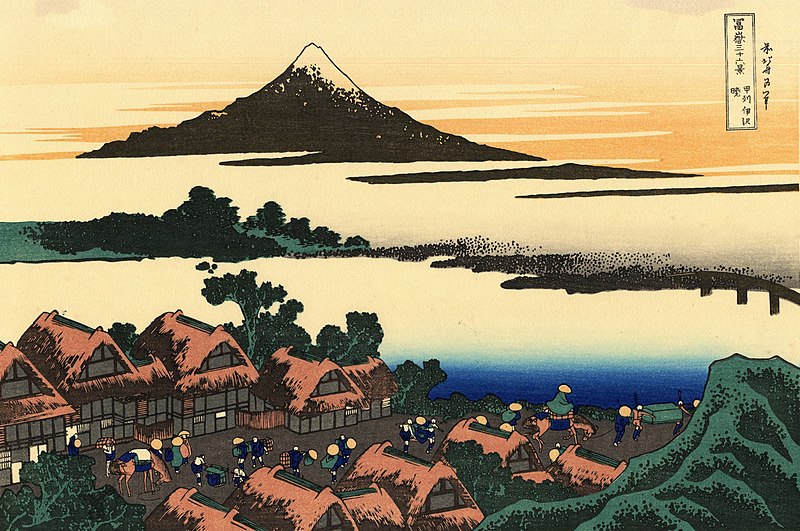
Colour woodblock oban print. View of Mt Fuji from north at dawn at Isawa: Travellers in deep round hats crowding road and making preparations for early departure: loading pack-horses and shouldering carrying poles; Fuefuki River behind inns, crossed by bridge on far right. http://www.britishmuseum.org/research/collection_online/collection_object_details.aspx?objectId=786273&partId=1
As the sun rises on the horizon, flushing the sky with a soft pink haze, travelers depart for a long journey. Passing through dark streets and past houses shut to the early-morning sky, the entourage slowly winds its way toward the bridge that will deliver them across the river toward Fuji. http://metmuseum.org/Collections/search-the-collections/56349?rpp=20&pg=1&rndkey=20140107&ao=on&ft=*&deptids=6&who=Katsushika+Hokusai&pos=16
Google maps http://goo.gl/maps/B3R6f
Kajikazawa in Kai Province 甲州石班沢 Kōshū Kajikazawa
36 Views of Mount Fuji #Hokusai Kajikazawa in Kai Province fishermen 19miles Northwest of the summit of Mount Fuji

Print shows a fisherman fishing from a rocky outcropping above waves, with view of Mount Fuji in the background. http://www.loc.gov/pictures/item/2008661011/

Fisherman casting lines into fast-flowing Fuji River at Kajikazawa; beside him small boy with basket seated on rock; peak of Mt. Fuji above clouds. http://www.britishmuseum.org/research/collection_online/collection_object_details.aspx?objectId=783958&partId=1
Map
http://www.maproom.org/00/05/sub1/1.html
facts and details http://factsanddetails.com/japan/cat25/sub165/item982.html
More
Hokusai Exposed: why great art should never be digitally remastered. A new show recreates the Japanese master's art so it looks like it did when it was originally made. It's a pointless exercise – and a creepy view of art's future. http://www.theguardian.com/artanddesign/jonathanjonesblog/2013/oct/24/hokusai-exposed-art-digitally-remastered

External links
http://www.tempustheatre.com/Hokusai.html http://www.asia.si.edu/exhibitions/online/hokusai/launch.htm
Katsushika Hokusai http://www.wikipaintings.org/en/katsushika-hokusai/mode/all-paintings
In this site dedicated to Japanese Woodblock Prints (Ukiyo-e and Shin-Hanga) you can: http://www.man-pai.com/index_e.htm http://www.man-pai.com/Grandes_series/Hokusai_Fuji36/Hokusai_36_vistas_monte_fuji.htm http://www.man-pai.com/bibliografia.htm
Historic noted places of Mt. Fuji http://homepage2.nifty.com/chigyoraku/fuji-viewingE03.html
Art of the Edo Period (1615–1868) http://www.metmuseum.org/toah/hd/edop/hd_edop.htm
http://kiritz.jp/2012/08/hokusai-thirty-six-views-of-mount-fuji-consists-of-46-pictures-in-all/
http://www.e-bookspdf.org/download/hokusai-fuji.html
- http://www.flickr.com/photos/stuckinthemetal/sets/72157605719168846/with/2595698175/
- Hokusai: 36 Views of Mount Fuji exhibition at the Freer and Sackler Galleries
- Hokusai's 36 Views of Mount Fuji
- A short biography of Hokusai including a section on the 36 Views of Mt. Fuji series.
- Jim Breen's ukiyo-e page on Hokusai and the 36 Views
- 葛飾北斎の富士山・富嶽三十六景 Template:Ja icon
- Educational Audio Tour of The Great Wave
http://io9.com/14-terrifying-japanese-monsters-myths-and-spirits-1498740680
